Fatigue Behavior of Cold-Worked High-Interstitial Steels
Abstract
1. Introduction
2. Materials and Methods
2.1. Investigated Steels
2.2. Fatigue Tests
2.3. Metallography and Microscopy
3. Results
3.1. Tensile Properties
3.2. Fatigue Properties
3.3. Microstructure
Microstructure of Cold-Worked Steels before and after Fatigue Testing
4. Discussion
4.1. Materials Science Aspects
4.2. Materials Engineering Aspects
Author Contributions
Funding
Acknowledgments
Conflicts of Interest
References
- Gavriljuk, V.G.; Berns, H. High Nitrogen Steels: Structure, Properties, Manufacture, Applications; Springer: Berlin, Germany, 1999. [Google Scholar]
- Vogt, J.B.; Degallaix, S.; Foct, J. Low cycle fatigue life enhancement of 316 L stainless steel by nitrogen alloying. Int. J. Fatigue 1984, 6, 211–215. [Google Scholar] [CrossRef]
- Degallaix, S.; Degallaix, G.; Foct, J. Influence of Nitrogen Solutes and Precipitates on Low Cycle Fatigue of 316l Stainless Steels; Solomon, H.D., Halford, G.R., Kaisand, L.P., Leis, B.N., Eds.; ASTM International: Bolton Landing, NY, USA, 1987; pp. 798–811. [Google Scholar]
- Tikhovskiy, I. Quasistatic, cyclic and electrochemical behavior of a high nitrogen austenitic stainless steel according to ISO 5832-9 in the solution annealed state. Unpublished work. 2003. [Google Scholar]
- Tikhovskiy, I.; Fischer, A.; Weiß, S. Cyclic deformation behaviour of austenitic crmnmon steel in solution annealed and cold worked states. In Proceedings of the HNS-Conference, Ostende, Belgium, 19–22 September 2014; GRIPS-Media GmbH: Bad Harzburg, Germany, 2004; pp. 259–263. [Google Scholar]
- Berns, H.; Gavriljuk, V.G.; Riedner, S.; Tyshchenko, A. High strength stainless austenitic crmncn steels—Part I: Alloy design and properties. Steel Res. Int. 2007, 78, 714–719. [Google Scholar] [CrossRef]
- Gavriljuk, V.G.; Razumov, O.; Petrov, Y.; Surzhenko, I.; Berns, H. High strength stainless austenitic crmncn steels—Part II: Structural changes by repeated impacts. Steel Res. Int. 2007, 78, 720–723. [Google Scholar] [CrossRef]
- Shanina, B.D.; Gavriljuk, V.G.; Berns, H. High strength stainless austenitic crmnn steels—Part III: Electronic properties. Steel Res. Int. 2007, 78, 724–728. [Google Scholar] [CrossRef]
- Berns, H.; Gavriljuk, V.; Riedner, S. High Interstitial Stainless Austenitic Steels; Springer Science & Business Media: Berlin, Germany, 2012. [Google Scholar]
- Orita, K.; Ikeda, Y.; Iwadate, T.; Ishizaka, J. Development and production of 18Mn-18Cr non-magnetic retaining ring with high yield strength. ISIJ Int. 1990, 30, 587–593. [Google Scholar] [CrossRef]
- Raman, S.G.S.; Padmanabhan, K.A. Effect of prior cold work on the room-temperature low-cycle fatigue behaviour of AISI 304LN stainless steel. Int. J. Fatigue 1996, 18, 71–79. [Google Scholar] [CrossRef]
- Göbbeler, P. Untersuchungen Zum Ermüdungsverhalten des Kaltumgeformten Austenitischen Implantatwerkstoffes X2 CrNiMo 18-15-3-1.4441; VDI Verlag: Düsseldorf, Germany, 1998; ISBN 3-18-351305-6. [Google Scholar]
- Schymura, M.; Fischer, A. Metallurgical aspects on the fatigue of solution-annealed austenitic high interstitial steels. Int. J. Fatigue 2014, 61, 1–9. [Google Scholar] [CrossRef]
- Schymura, M.; Fischer, A. Fatigue of austenitic high interstitial steels—The role of N and C. In Proceedings of the 11th International Fatigue Congress, FATIGUE 2014, Melbourne, Australia, 2–7 March 2014; Trans Tech Publications: Melbourne, Australia, 2014; Volumes 891–892, pp. 403–409. [Google Scholar]
- Fischer, A.; Weiss, S.; Wimmer, M.A. The tribological difference between biomedical steels and cocrmo-alloys. J. Mech. Behav. Biomed. Mater. 2012, 1, 50–62. [Google Scholar] [CrossRef] [PubMed]
- Gavriljuk, V.G.; Shanina, B.D.; Berns, H. A physical concept for alloying steels with carbon + nitrogen. Mater. Sci. Eng. A 2008, 481–482, 707–712. [Google Scholar] [CrossRef]
- Berns, H.; Gavriljuk, V.G.; Nabiran, N.; Petrov, Y.N.; Riedner, S.; Trophimova, L.N. Fatigue and structural changes of high interstitial stainless austenitic steels. Steel Res. Int. 2010, 81, 299–307. [Google Scholar] [CrossRef]
- Schramm, R.E.; Reed, R.P. Stacking fault energies of seven commercial austenitic stainless steels. Metall. Trans. A 1975, 6, 1345–1351. [Google Scholar] [CrossRef]
- Remy, L. Temperature variation of the intrinsic stacking fault energy of a high manganese austenitic steel. Acta Metall. 1977, 25, 173–179. [Google Scholar] [CrossRef]
- Stoltz, R.E.; Vander Sande, J.B. The effect of nitrogen on stacking fault energy of Fe-Ni-Cr-Mn steels. Metall. Trans. A 1980, 11, 1033–1037. [Google Scholar] [CrossRef]
- Gavriljuk, V.; Petrov, Y.; Shanina, B. Effect of nitrogen on the electron structure and stacking fault energy in austenitic steels. Scr. Mater. 2006, 55, 537–540. [Google Scholar] [CrossRef]
- Mujica, L.; Weber, S.; Theisen, W. The stacking fault energy and its dependence on the interstitial content in various austenitic steels. Mater. Sci. Forum 2012, 706–709, 2193–2198. [Google Scholar] [CrossRef]
- Das, A. Revisiting stacking fault energy of steels. Metall. Mater. Trans. 2016, 47, 748–768. [Google Scholar] [CrossRef]
- Wang, Z. Cyclic deformation response of planar-slip materials and a new criterion for the wavy-to-planar-slip transition. Philos. Mag. 2004, 84, 351–379. [Google Scholar] [CrossRef]
- Murayama, M.; Hono, K.; Hirukawa, H.; Ohmura, T.; Matsuoka, S. The combined effect of molybdenum and nitrogen on the fatigued microstructure of 316 type austenitic stainless steel. Scr. Mater. 1999, 41, 467–473. [Google Scholar] [CrossRef]
- Tikhovskiy, I. Untersuchungen zum Zyklischen Verformungsverhalten des Hochstickstofflegierten Austenitischen Stahles X13CrMnMoN 18-14-3(1.4452); Materials Science and Engineering; s.a. Fortschr.-Ber. VDI Reihe 5: Grund-und Werkstoffe/Kunststoffe, Nr. 717; VDI Verlag: Düsseldorf, Germany, 2005; ISBN 3-18-371705-0. [Google Scholar]
- Mitchell, M.R. Fundamentals of modern fatigue analysis for design. In Science Seminar, 10 Materials Science Division of Asm; ASM Materials: St. Louis, MO, USA, 1978; pp. 14–15. [Google Scholar]
- Nieslony, A.; el Dsoki, C.; Kaufmann, H.; Krug, P. New method for evaluation of the Manson-Coffin-Basquin and Ramberg-Osgood equations with respect to compatibility. Int. J. Fatigue 2008, 30, 1967–1977. [Google Scholar] [CrossRef]
- Güler, S. Einfluss der Kaltverformung auf das Ermüdungsverhalten von Austenitischen Hochinterstitiell Legierten Stählen. Ph.D. Thesis, University of Duisburg-Essen, Duisburg, Germany, 2017. [Google Scholar]
- Tikhovskiy, I.; Weiß, S.; Fischer, A. Cyclic deformation behaviour of austenitic crmnmon steel in solution annealed and cold-worked states. Steel Grips 2004, 2, 259–263. [Google Scholar]
- Li, J.; Yang, Y.; Ren, Y.; Dong, J.; Yang, K. Effect of cold deformation on corrosion fatigue behavior of nickel-free high nitogen austenitic stainless steel for coronary stent application. J. Mater. Sci. Technol. 2017, 34, 660–665. [Google Scholar] [CrossRef]
- Shao, C.W.; Zhang, P.; Liu, R.; Zhang, Z.J.; Pang, J.C.; Zhang, Z.F. Low-cycle and extremely-low-cycle fatigue behaviors of high-mn austenitic trip/twip alloys: Property evaluation, damage mechanisms and life prediction. Acta Mater. 2016, 103, 781–795. [Google Scholar] [CrossRef]
- Lambers, H.G.; Rüsing, C.J.; Niendorf, T.; Geissler, D.; Freudenberger, J.; Maier, H.J. On the low-cycle fatigue response of pre-strained austenitic Fe61Mn 24Ni 6.5Cr 8.5 alloy showing twip effect. Int. J. Fatigue 2012, 40, 51–60. [Google Scholar] [CrossRef]
- Riedner, S. Höchstfeste Nichtrostende Austenitische Crmn-Stähle Mit (C+N); Ruhr Universität Bochum: Bochum, Germany, 2010. [Google Scholar]
- Güler, S.; Schymura, M.; Fischer, A. Austenitic high interstitial steels vs. Cocrmo—Comparison of fatigue behavior. Int. J. Fatigue 2015, 75, 145–152. [Google Scholar] [CrossRef]
- Polak, J.; Obrtlik, K.; Hajek, M. Cyclic plasticity in type 316l austenitic stainless steel. Fatigue Fract. Eng. Mater. Struct. 1994, 17, 773–782. [Google Scholar] [CrossRef]
- Shao, C.W.; Zhang, P.; Liu, R.; Zhang, Z.J.; Pang, J.C.; Duan, Q.Q.; Zhang, Z.F. A remarkable improvement of low-cycle fatigue resistance of high-mn austenitic twip alloys with similar tensile properties: Importance of slip mode. Acta Mater. 2016, 118, 196–212. [Google Scholar] [CrossRef]
- Gerold, V.; Karnthaler, H.P. On the origin of planar slip in fcc Alloys. Acta Metall. 1989, 37, 2177–2183. [Google Scholar] [CrossRef]
- Güler, S.; Schymura, M.; Fischer, A.; Droste, M.; Biermann, H. The influence of the nitrogen/nickel-ratio on the cyclic behavior of austenitic high strength steels with twinning-induced plasticity and transformation-induced plasticity effects. Materialwissenschaft und Werkstofftechnik 2018, 49, 61–72. [Google Scholar] [CrossRef]
- Buchinger, L.; Cheng, A.S.; Stanzl, S.; Laird, C. The cyclic stress-strain response and dislocation structures of Cu-16 at. %Al alloy III: Single crystals fatigued at low strain amplitudes. Mater. Sci. Eng. 1986, 80, 155–167. [Google Scholar] [CrossRef]
- Christ, H.J. Wechselverformung von Metallen; Springer: Berlin, Germany, 1991. [Google Scholar]
- Schymura, M.; Stegemann, R.; Fischer, A. Crack propagation behavior of solution annealed austenitic high interstitial steels. Int. J. Fatigue 2015, 79, 25–35. [Google Scholar] [CrossRef]
- Gavriljuk, V.G.; Tyshchenko, A.I.; Bliznuk, V.V.; Yakovleva, I.L.; Riedner, S.; Berns, H. Cold work hardening of high-strength austenitic steels. Steel Res. Int. 2008, 79, 413–422. [Google Scholar] [CrossRef]

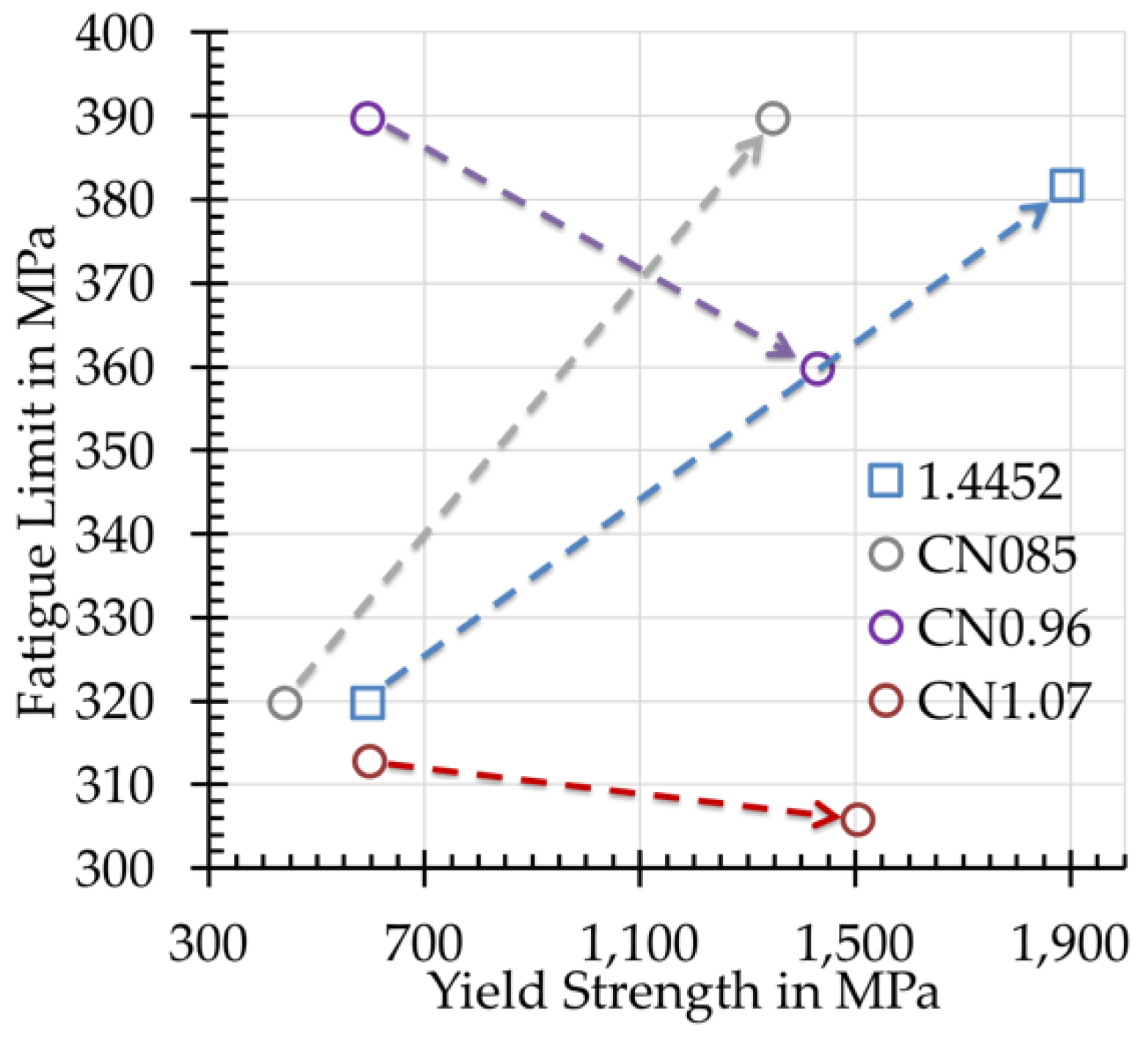
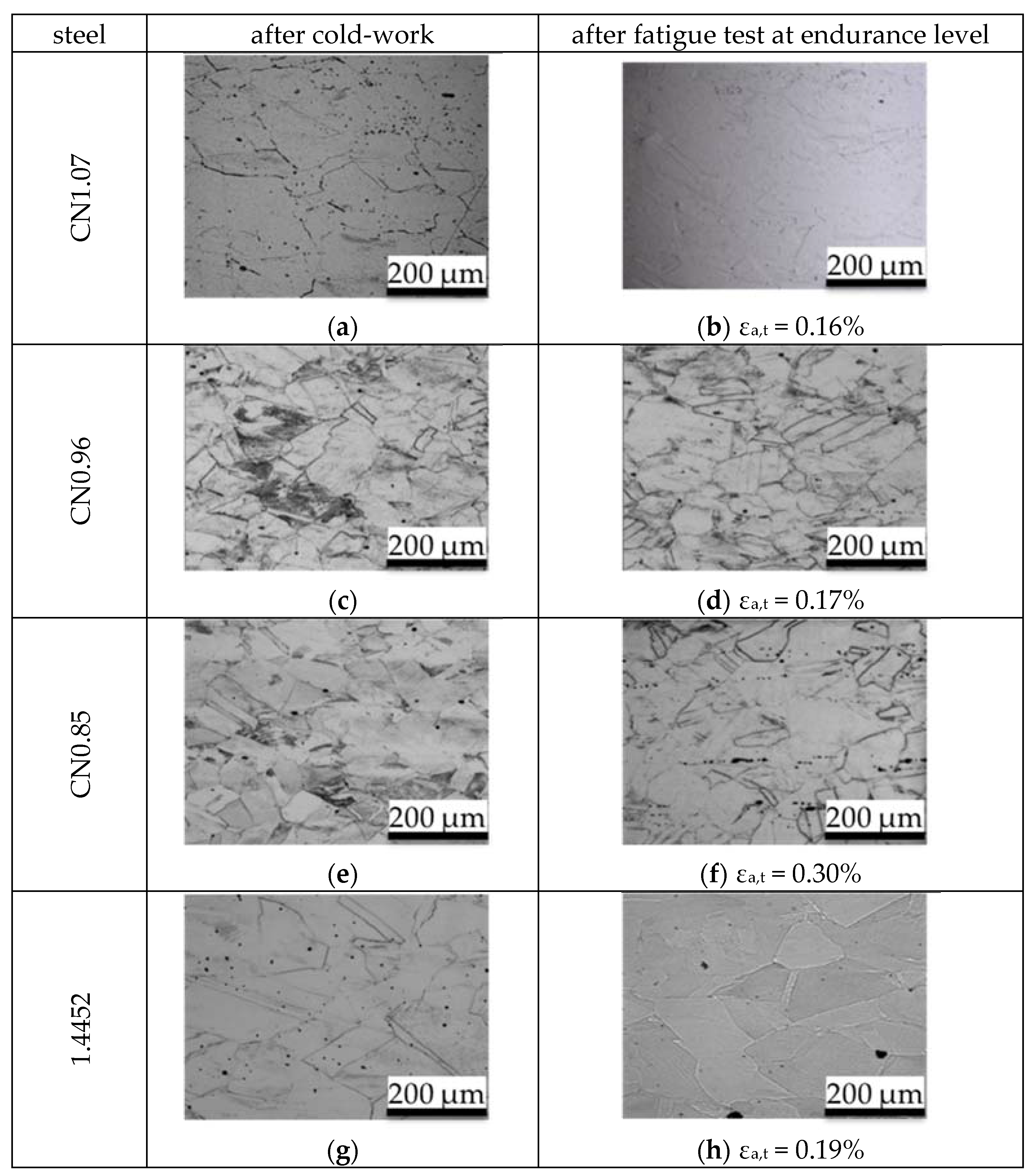
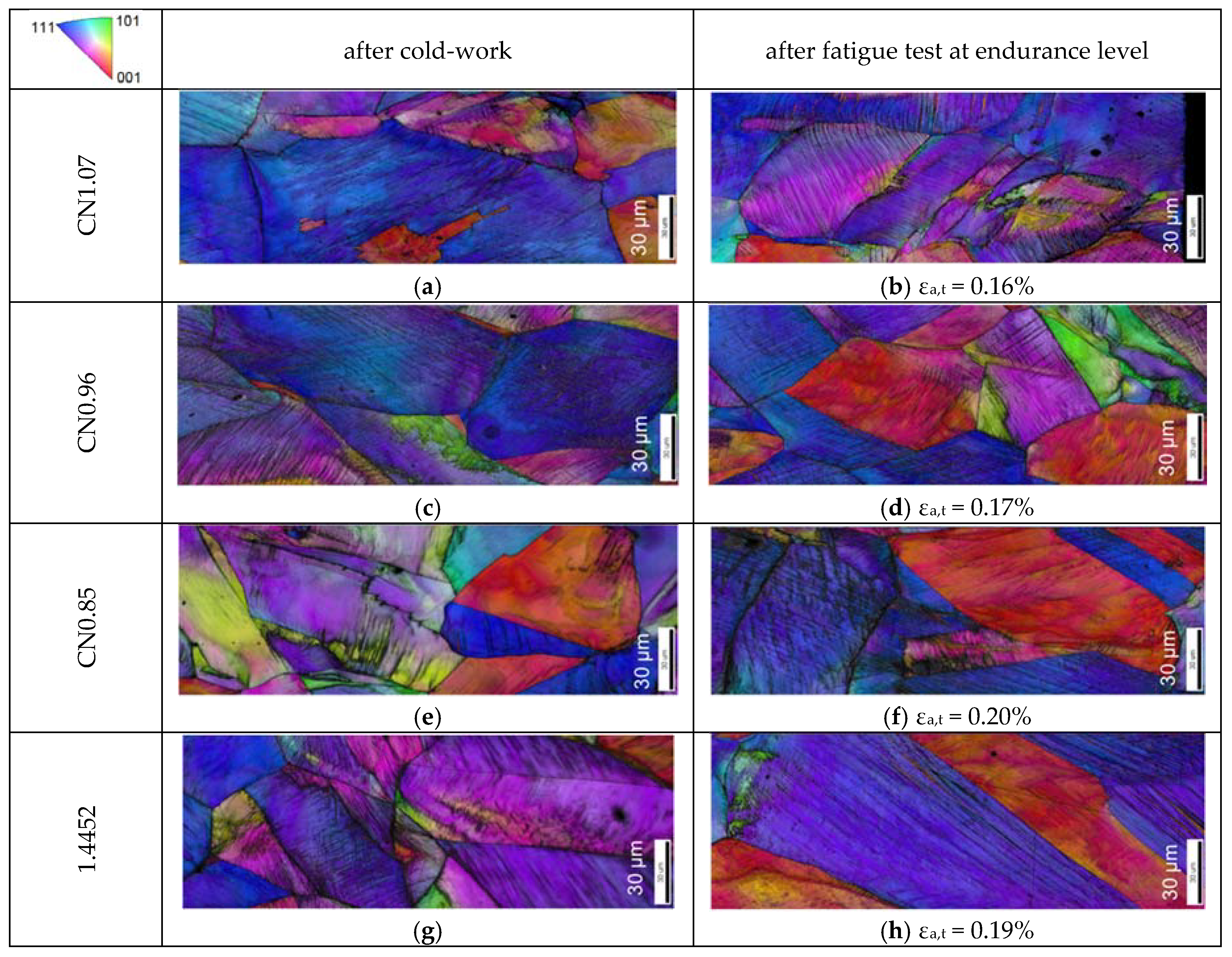
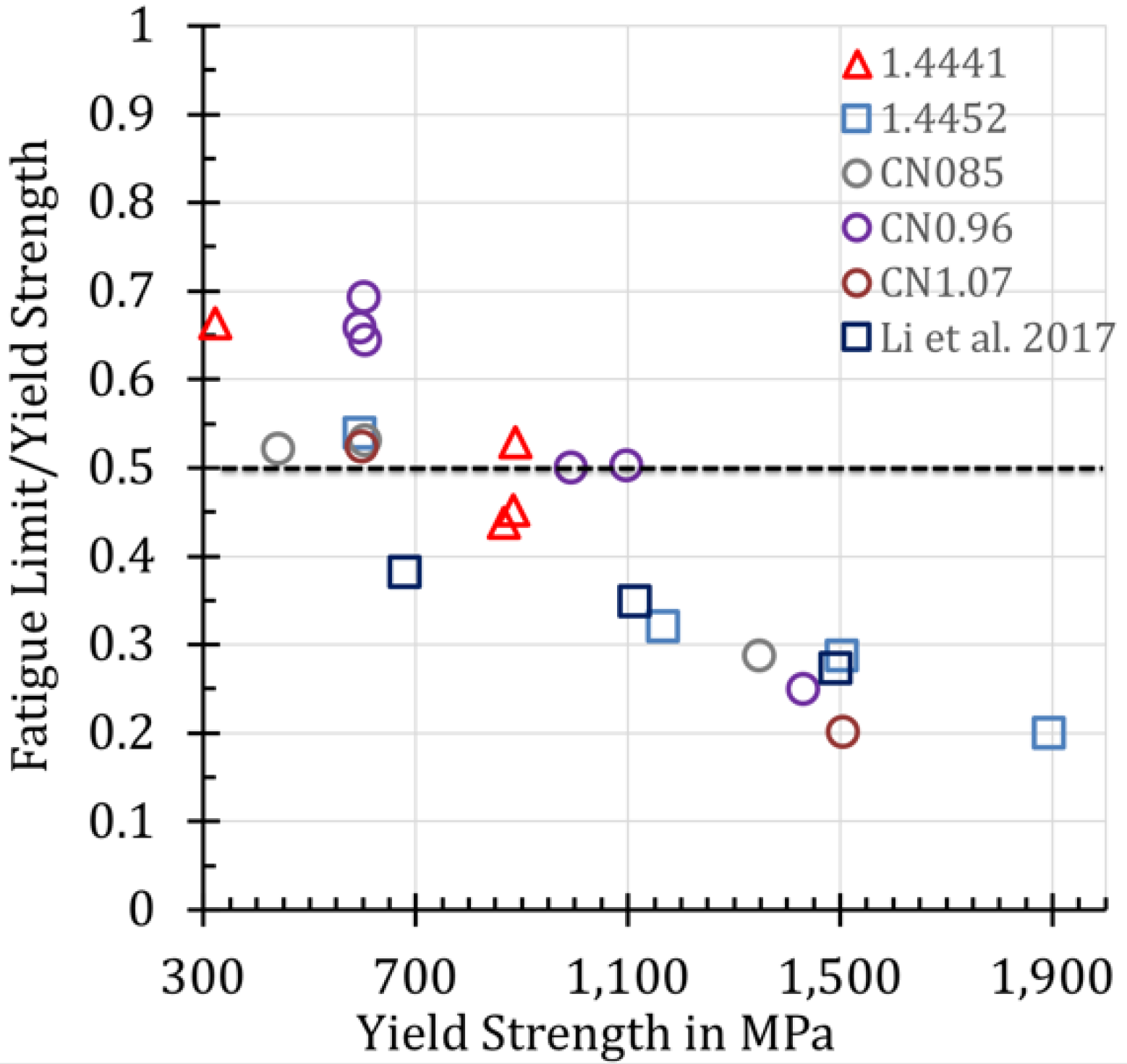
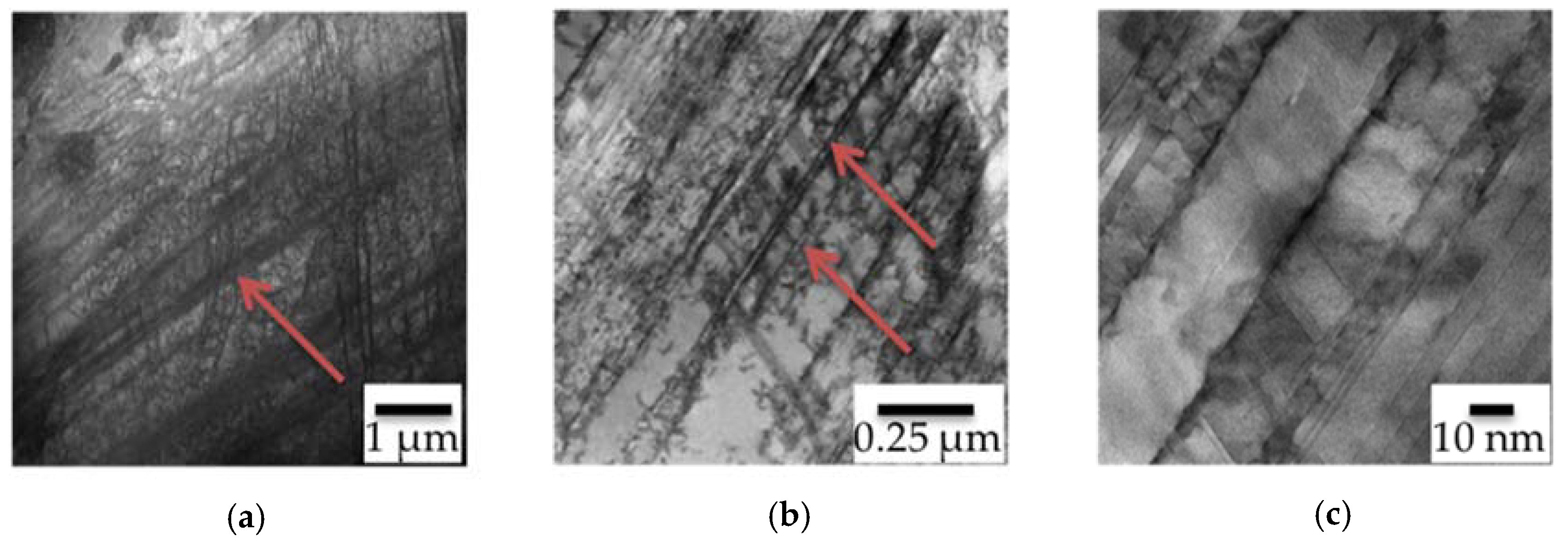
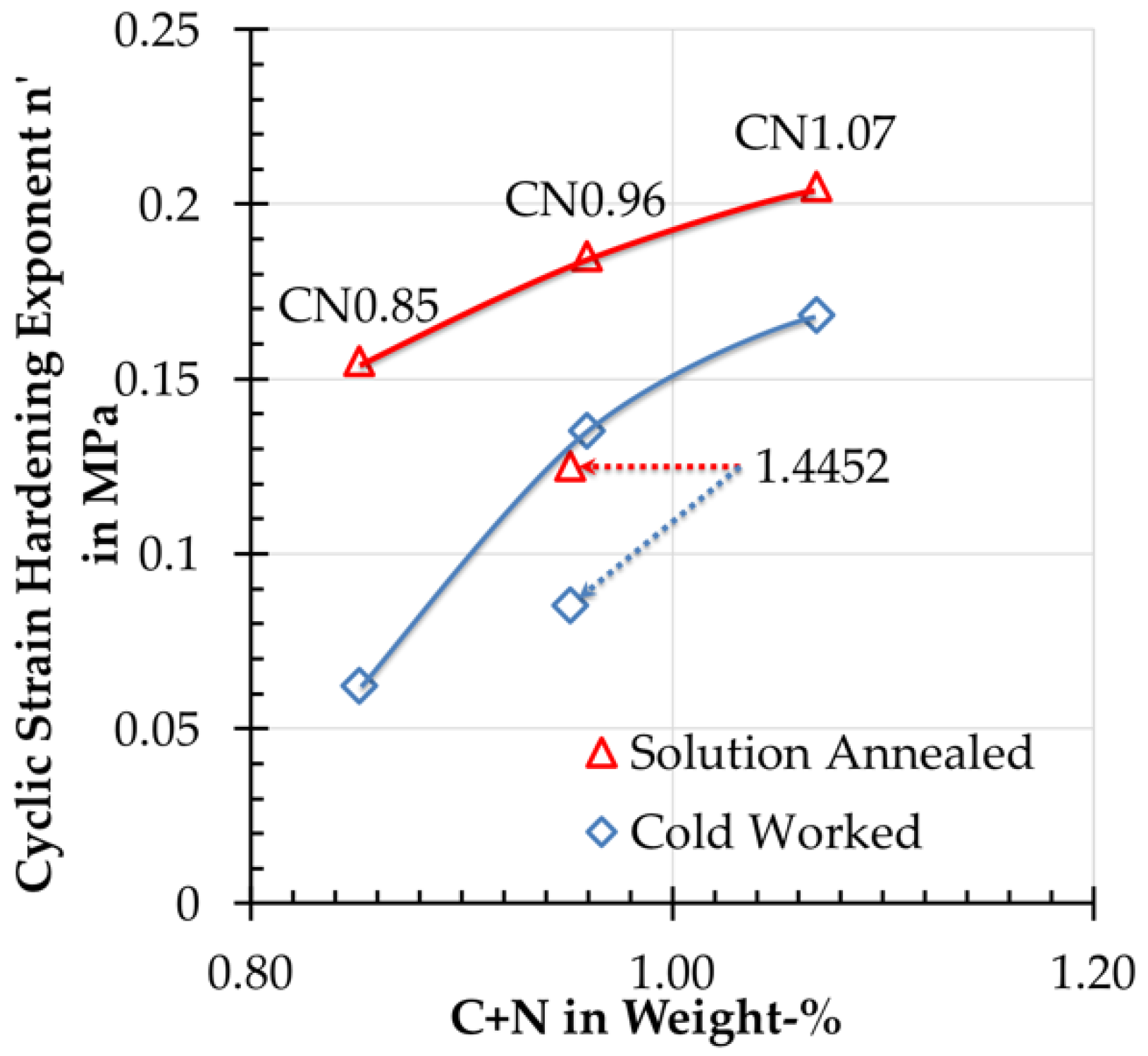
| Steel | 1.4452 | CN0.85 | CN0.96 | CN1.07 |
|---|---|---|---|---|
| Designation | CrMnMoCN0.95 | CrMnCN0.85 | CrMnCN0.96 | CrMnCN1.07 |
| C | 0.08 | 0.26 | 0.34 | 0.49 |
| Cr | 18.00 | 18.26 | 18.20 | 18.82 |
| Fe | bal. | bal. | bal. | bal. |
| Mn | 14.00 | 18.52 | 18.89 | 18.88 |
| Mo | 3.50 | 0.04 | 0.06 | 0.07 |
| N | 0.88 | 0.59 | 0.61 | 0.58 |
| Ni | 0.12 | 0.26 | 0.34 | 0.41 |
| Si | 1.12 | 0.26 | 0.3 | 0.43 |
| C+N | 0.95 | 0.85 | 0.96 | 1.07 |
| N/C | 11.67 | 2.27 | 1.78 | 1.18 |
| Steel | 1.4452 | CN0.85 | CN0.96 | CN1.07 |
|---|---|---|---|---|
| Designation | CrMnMoCN0.95 | CrMnCN0.85 | CrMnCN0.96 | CrMnCN1.07 |
| Solution annealed [13] | ||||
| Yield strength Rp0.2 in MPa | 631 ± 13 | 587 ± 17 | 595 ± 9 | 585 ± 10 |
| Tensile strength Rm in MPa | 1022 ± 23 | 1000 ± 14 | 1027 ± 16 | 1044 ± 8 |
| Elongation to fracture A in % | 66 ± 3 | 64 ± 8 | 66 ± 2 | 67 ± 7 |
| Hardness HV10 | 260 ± 5 | 270 ± 4 | 271 ± 9 | 278 ± 13 |
| 40% Cold worked | 35% Cold worked | |||
| Yield strength Rp0.2 in MPa | 1890 ± 15 | 1343 ± 12 | 1425 ± 7 | 1500 ± 13 |
| Tensile strength Rm in MPa | 1901 ± 9 | 1374 ± 11 | 1432 ± 9 | 1520 ± 5 |
| Elongation to fracture A in % | 18 ± 7 | 45 ± 9 | 43 ± 4 | 34 ± 2 |
| Hardness HV10 | 510 ± 9 | 464 ± 8 | 472 ± 7 | 475 ± 12 |
| Steel | 1.4452 | CN0.85 | CN0.96 | CN1.07 |
|---|---|---|---|---|
| Designation | CrMnMoCN0.95 | CrMnCN0.85 | CrMnCN0.96 | CrMnCN1.07 |
| Solution annealed | ||||
| Total strain amplitude εa,t in % at fatigue limit | 0.16 | 0.17 | 0.2 | 0.16 |
| Fatigue limit σD in MPa | 320 | 320 | 390 | 313 |
| R2 of σD | 0.98 | 0.96 | 0.99 | 0.99 |
| Youngs-Modulus E in GPa | 200 | 188 | 195 | 196 |
| Cyclic strain hardening exponent n’ in MPa | 0.126 | 0.156 | 0.186 | 0.206 |
| Cyclic strength coefficient K’ in MPa | 1.041 | 1.093 | 1.258 | 1.375 |
| 40% Cold worked | 35% Cold worked | |||
| Total strain amplitude εa,t in % at fatigue limit | 0.19 | 0.2 | 0.18 | 0.16 |
| Fatigue limit σD in MPa | 382 | 390 | 360 | 306 |
| R2 of σD | 0.88 | 0.93 | 0.92 | 0.85 |
| Youngs-Modulus E in GPa | 201 | 195 | 200 | 191 |
| Cyclic strain hardening exponent n’ in MPa | 0.086 | 0.063 | 0.136 | 0.169 |
| Cyclic strength coefficient K’ in MPa | 1.382 | 1.111 | 1.769 | 2.539 |
© 2018 by the authors. Licensee MDPI, Basel, Switzerland. This article is an open access article distributed under the terms and conditions of the Creative Commons Attribution (CC BY) license (http://creativecommons.org/licenses/by/4.0/).
Share and Cite
Güler, S.; Fischer, A. Fatigue Behavior of Cold-Worked High-Interstitial Steels. Metals 2018, 8, 442. https://doi.org/10.3390/met8060442
Güler S, Fischer A. Fatigue Behavior of Cold-Worked High-Interstitial Steels. Metals. 2018; 8(6):442. https://doi.org/10.3390/met8060442
Chicago/Turabian StyleGüler, Sedat, and Alfons Fischer. 2018. "Fatigue Behavior of Cold-Worked High-Interstitial Steels" Metals 8, no. 6: 442. https://doi.org/10.3390/met8060442
APA StyleGüler, S., & Fischer, A. (2018). Fatigue Behavior of Cold-Worked High-Interstitial Steels. Metals, 8(6), 442. https://doi.org/10.3390/met8060442





